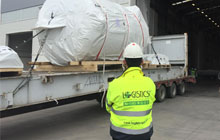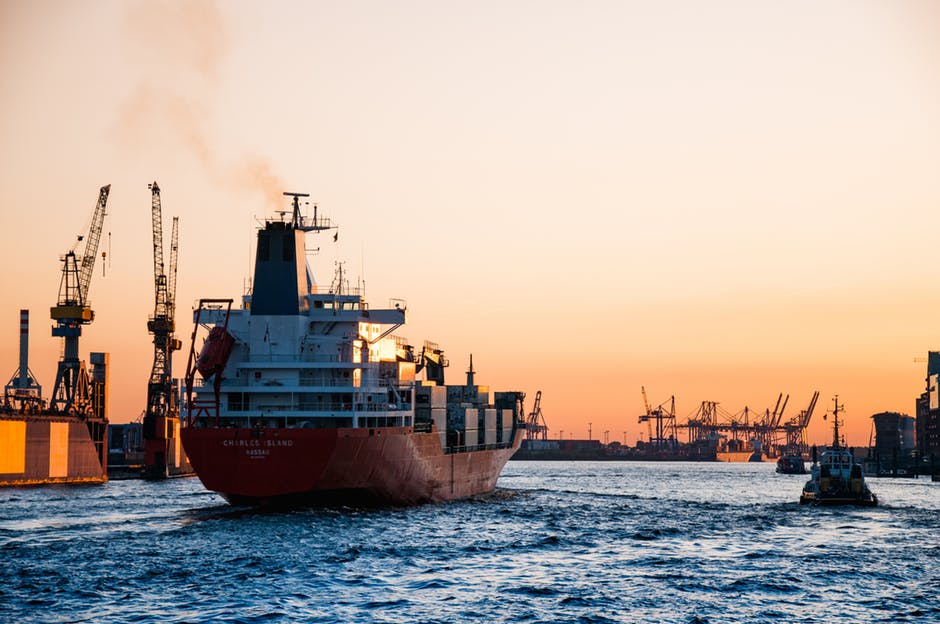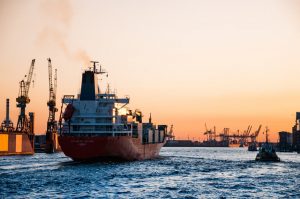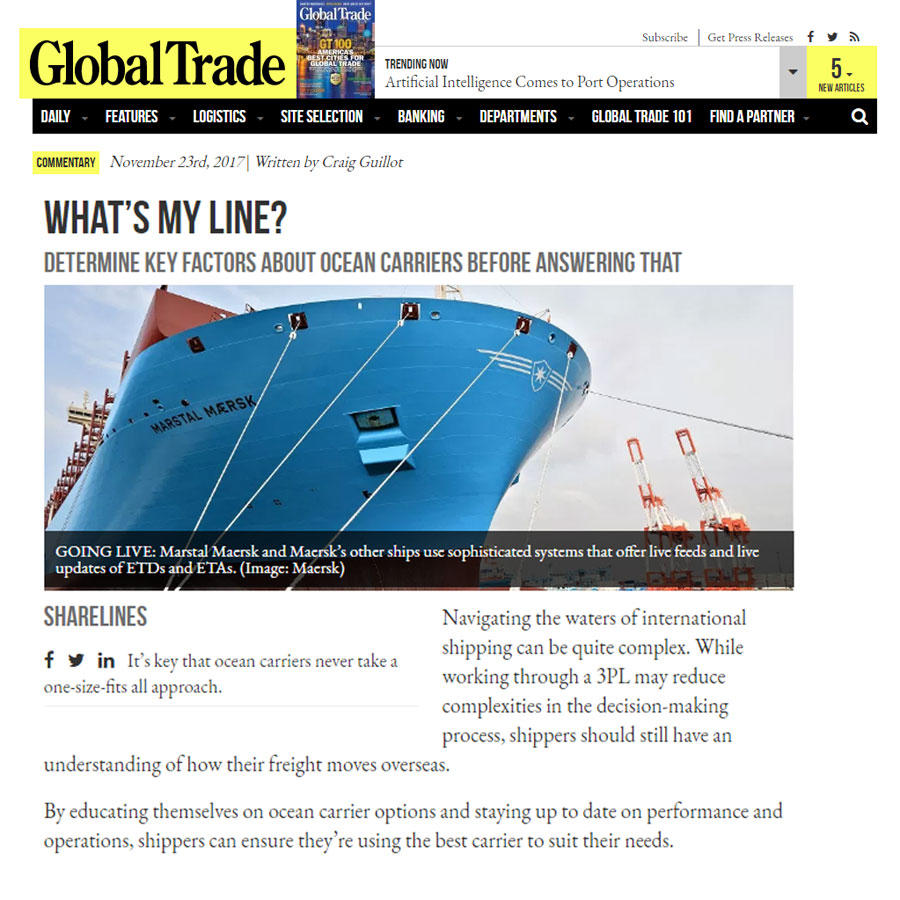
by Marketing | Jun 1, 2018 | News
What is Project Cargo?
 Project cargo, also known as project forwarding or project logistics, is the transportation of large, complex, or high-value pieces of equipment, including break bulk shipments, that can move by land, sea, or air. This process involves single or multiple shipments with the help of cranes, trucks, rail, planes, and ships. Furthermore, project cargo tends to have a specific time-frame or specified delivery date that makes these shipments some of the most complex and detailed projects in the entire logistics industry.
Project cargo, also known as project forwarding or project logistics, is the transportation of large, complex, or high-value pieces of equipment, including break bulk shipments, that can move by land, sea, or air. This process involves single or multiple shipments with the help of cranes, trucks, rail, planes, and ships. Furthermore, project cargo tends to have a specific time-frame or specified delivery date that makes these shipments some of the most complex and detailed projects in the entire logistics industry.
Getting Started:
Pre-planning is crucial
Every successful cargo project begins with an organized and detailed plan. Making adequate time to organize and plan every detail of this process can save shippers a significant amount of time and money, while also reducing the risk of unexpected events.
Work on a contingency plan
There is always a chance that unpredictable or unanticipated events can impact the pre-planned strategy. It’s important to consider every alternative and have a backup plan if something goes wrong. Making sure you have an appropriate contingency plan in place can help ensure success with all deliveries.
Execution
Once all plans are in place, it’s time to begin transporting the product. Every country has different protocols when it comes to customs compliance, paper work, duties, exemptions, authorizations, and other considerations that must be followed. Typically, an experienced project cargo manager can assist firms with all the regulatory considerations and budgeting process, as well as providing insights into the shipment design, packaging, routing options, and appropriate choices for final delivery. The execution of project cargo transportation should be just as comprehensive as the pre-planning stage. Based on transit times and other factors, a project cargo manager will meticulously execute the detailed plans while maintaining liability, constant communication, and overall transparency.
Work on constant improvement
Project cargo transportation always has room for improvement. Tracking and analyzing the results of finished projects will lead to further improvements on future shipments.
Why choose Logistics Plus for project cargo and break bulk shipments?
1) We have over 20 years of project cargo expertise
2) Award-winning service and market competitive rates
3) Our global network of people, locations, and resources
4) Cargo visibility and responsiveness to potential problems
5) World-class technology and transportation management tools
If you’re interested in our award-winning service, click below to receive a free project cargo quote today or email us at projectcargo@logisticsplus.com.


by Marketing | Feb 21, 2018 | News

Over the span of 10 years, the ocean freight transportation industry has been challenged by global supply and demand disparity throughout the market, affecting both carriers and shippers. On occasion, there is overcapacity in the market, causing a major decline in the rates. There are also occurrences in which demand quickly increases, causing the rates to spike. Ocean carriers have benefited from these periods of increased demand, triggering rates to shoot up and become more unstable and challenging for shippers to allocate and purchase space.
One of the driving variables of this global supply and demand imbalance was Maersk’s fleet venture initiative: Maersk sought to control the worldwide container market and drive existing industry rates. They started building more vessels to achieve this goal. However, this plan was interrupted by the Great Recession of 2007-2009, when supply decreased rapidly for container shipping.
The recession instigated a chain reaction for ocean carriers, making it vital to ensure that freight rates didn’t tumble too far. In response, ocean carriers began forming new alliances and incorporating the following strategies:
- Slow steaming: conserve fuel and increase transit times
- Vessel idling: remove vessels from the rotation during slow periods
- Organizational cost-cutting: layoffs within the company
- IT modernization: large investments into technology and creating a more automated system
The Main Three
What used to be four main alliances has recently changed into three larger unions. The current state of the three-carrier alliance takes into account almost 80% of the container trade in the world and nearly 90% of container volume on primary trade lanes.
- 2M Alliance (MSC, Maersk, Hamburg Sud, Hyundai)
- Ocean Alliance (CMA CGM, APL, COSCO, China Shipping, OOCL, Evergreen)
- The Alliance (NYK Group, “K” Line, MOL, Yang Ming, Hapag-Lloyd, UASC)
The absence of competition that has been created due to these major unions has permitted carriers to recapture productivity, control rate changes, and space accessibility. As a shipper looking for other possibilities, it can be troubling that five or six worldwide carriers control all major international trade routes.
New Carrier Alliance
Three Japan-based container shipping carriers are paring up to create a new joint venture, entitled Ocean Network Express (ONE). These carriers are comprised of Kawasaki Kisen Kaisha, Ltd. (K-Line), Mitsui O.S.K. Lines, Ltd. (MOL), and Nippon Yusen Kabushiki Kaisha (NYK). The development of the joint venture is said to merge the companies’ container shipping business, including global terminal operation business. By offering high-quality, competitive services through the enhancement and alliance of the three companies’ global network and service structures, Ocean Network Express will be capable of better meeting customers’ needs. The company has also been working towards its goal of launching the new JV. Once all anti-trust reviews are finalized, the establishment of the new JV will officially be publicized. The start date for Ocean Network Express is set for April 1, 2018.
Benefits:
- Provide service across 90 countries
- Fleet size of 1.4 million TEU (Twenty-Foot Equivalent Units)
- Represents around 7% of the global share
The Power of Carrier Alliances
Advantages of the carrier alliances include:
- Less competition, while at the same time greater control of vessels
- Better management of ship capacity
- More effective coordination of future ship orders with forecasted demand
- A lowering in operating costs by more effective collaboration with service providers, such as ports, terminal operators, stevedores, tugboat providers, and container lessors
- Enhanced reach, that will allow alliance partners to service new ports and maximize the potential of new routes
Concerns due to the alliances include:
- Terminal congestion
- Chassis dislocations: raises concerns that the shipper or importer may be bearing the brunt of that impact and paying any associated dislocation fees.
- Delays in spotting and releasing intermodal trains: intermodal trains have been delayed or had other challenges due to increased congestion and ship bunching
The history of the maritime industry has traditionally been one of feast or famine. Large swings in vessel capacity and shipper demand have made for a turbulent environment in terms of financing and planning for the future. The formation of shipping alliances has helped to mitigate these issues and serve as a strong incentive to continue and strengthen them.
Logistics Plus can be your trusted partner in navigating the challenges of dealing with and arranging your logistical needs with these large organizations.


by logisticsplus | Feb 6, 2018 | News
 Chinese New Year is the first day of the year in the Chinese calendar. Chinese New Year is also known as the Spring Festival in modern China, or simply the Lunar New Year, is the most important and longest of all Chinese holidays. The first day of the Chinese New Year 2018, the year of the dog will be celebrated Thursday, February 15, 2018, until February 21, 2018. As you might imagine, given the prominence of Chinese global commerce, the holiday has a huge impact on global supply chains around the world.
Chinese New Year is the first day of the year in the Chinese calendar. Chinese New Year is also known as the Spring Festival in modern China, or simply the Lunar New Year, is the most important and longest of all Chinese holidays. The first day of the Chinese New Year 2018, the year of the dog will be celebrated Thursday, February 15, 2018, until February 21, 2018. As you might imagine, given the prominence of Chinese global commerce, the holiday has a huge impact on global supply chains around the world.
Government, construction, and factories are generally closed for most of the Spring Festival (including the Logistics Plus offices in China), while ports and customs usually operate with a skeleton staff focusing on perishable priority items. Many manufacturers treat the holiday as an annual break and will subsequently shut down for two weeks or longer. With this year’s holiday falling a full 19 days later than it did in 2017, the 2018 Chinese New Year will be different, with normal freight flows resuming in mid-to-late March, according to John Paul Hampstead, staff writer for FreightWaves.com.
If you have Chinese imports or exports, hopefully, you have already planned ahead for this annual supply chain disruption (most suppliers have probably already stopped accepting orders until after the holiday). Different manufacturers might have different schedules, so it is best to coordinate individually with each of your overseas suppliers. Planning and coordination are key to ensuring your supply chain continues to run smoothly before, during, and after the Chinese New Year.
If you need help shifting your supply chain back into high-gear following the Chinese New Year, the global import & export experts at Logistics Plus are here to help. As a top freight forwarder and NVOCC, we can help you secure affordable air freight and ocean freight transportation, and we can provide you with customs brokerage and global trade compliance support. Shipping documents (e.g., BOL entry, arrival notice, custom filings), tariff filings, VGM submissions, cargo tracking, freight rate management, and more – we’ve got you covered! Once your goods arrive in the U.S., we can provide warehousing and fulfillment, and transportation solutions as needed too. Contact us today!

PS: As a reminder, Logistics Plus China offices will also be closed from February 15 through February 21 for the holiday. Those offices will resume normal operations on February 22. During that time period, all other Logistics Plus locations stand ready to help you with your international shipping needs.

by logisticsplus | Nov 27, 2017 | News
 The folks at Global Trade magazine recently published a new article titled “What’s My Line? Determine Key Factors About Ocean Carriers Before Answering That.” The article discusses how shippers can work with 3PLs to better educate themselves on ocean carrier options and ensure they’re using the best carrier to suit their needs. Since Logistics Plus is an experienced ocean freight forwarder and NVOCC, it made perfect sense that the author, Craig Guillot, should interview Yuriy Ostapyak, director of global operations for Logistics Plus, for the finished piece. You can read the online version of the article here http://www.globaltrademag.com/global-logistics/whats-my-line (or by clicking the image below).
The folks at Global Trade magazine recently published a new article titled “What’s My Line? Determine Key Factors About Ocean Carriers Before Answering That.” The article discusses how shippers can work with 3PLs to better educate themselves on ocean carrier options and ensure they’re using the best carrier to suit their needs. Since Logistics Plus is an experienced ocean freight forwarder and NVOCC, it made perfect sense that the author, Craig Guillot, should interview Yuriy Ostapyak, director of global operations for Logistics Plus, for the finished piece. You can read the online version of the article here http://www.globaltrademag.com/global-logistics/whats-my-line (or by clicking the image below).


by Marketing | Jun 6, 2017 | News
 Shipping between the U.S. and Mexico is not as easy as it may seem. In order to transport shipments between these countries, there are certain regulations and documents that must be legally followed. The most common methods of shipping goods from the United States to Mexico are by truck, rail, air and sea, or a mixture of two or more of these transportation modes.
Shipping between the U.S. and Mexico is not as easy as it may seem. In order to transport shipments between these countries, there are certain regulations and documents that must be legally followed. The most common methods of shipping goods from the United States to Mexico are by truck, rail, air and sea, or a mixture of two or more of these transportation modes.
Here’s what you need to know when you’re shipping from the U.S. to Mexico:
- An American carrier will transport your cargo to the border and deliver it to the designated carrier who has been selected / hired by the Mexican consignee (the recipient of his goods).
- The carrier receives your shipment, inspects the cargo, checks all documents and prepares the shipment to enter Mexico on behalf of the Mexican customs agent who is handling your shipment.
- The Mexican customs agent will formally present the Mexican customs entry on behalf of the Mexican consignee.
- Now it’s time for your cargo to cross the border! A third party transportation company will ship your shipment across the border, through customs, and then deliver it to the selected Mexican carrier’s facility.
- Finally, the Mexican carrier transports its cargo inland to its final destination in Mexico, the consignee
Here’s what you need to know when you’re shipping from Mexico to the U.S:
- A Mexican carrier transports its cargo to the border city.
- A Mexican customs agent formally presents the entry of the Mexican export customs on behalf of the Mexican sender so that the goods can legally leave the country.
- A licensed U.S. customs agent then files the U.S. customs clearance so that the shipment can enter the U.S. on behalf of the U.S. importer of record (the consignee).
- A third party transportation company will ship your shipment across the border, through the U.S. Customs, and deliver the shipment to the selected U.S. carrier’s premises.
- The U.S. carrier transports the freight to the final destination.
Here are the basic import and export documents you’ll need:
- Import /export form
- Commercial invoice
- Bill of lading
- NAFTA Certificate of Origin (only if goods qualify for NAFTA)
Every country has its own regulations and shipping requirements so it’s important to be aware of this information before shipping to any country. Contact our team of cross-border experts here at Logistics Plus to learn more about shipping between the U.S and Mexico.

Page 5 of 13« First«...34567...10...»Last »

 Project cargo, also known as project forwarding or project logistics, is the transportation of large, complex, or high-value pieces of equipment, including break bulk shipments, that can move by land, sea, or air. This process involves single or multiple shipments with the help of cranes, trucks, rail, planes, and ships. Furthermore, project cargo tends to have a specific time-frame or specified delivery date that makes these shipments some of the most complex and detailed projects in the entire logistics industry.
Project cargo, also known as project forwarding or project logistics, is the transportation of large, complex, or high-value pieces of equipment, including break bulk shipments, that can move by land, sea, or air. This process involves single or multiple shipments with the help of cranes, trucks, rail, planes, and ships. Furthermore, project cargo tends to have a specific time-frame or specified delivery date that makes these shipments some of the most complex and detailed projects in the entire logistics industry.







 The folks at
The folks at 
